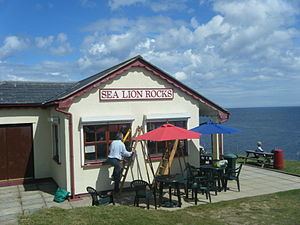Parking None | Platforms Ground Level | |
 | ||
Tracks One Running Line & Loop Structure type Tea Room & Visitor Centre Similar Lhen Coan railway station, Groudle Glen railway st, Isle of Man Railway, Derby Castle terminus, Douglas Bay Horse Tramway | ||
Sea Lion Rocks is a railway station and outer terminus of the Groudle Glen Railway in the Isle of Man. It served as the outer terminus from 1896 until 1939 and again from 1992 to date.
Contents
Location
The terminus is situated some three-quarters of a mile away from the other end of the line. It was opened in 1896 and closed at the outbreak of the Second World War; a landslip during the war years prevented the line being re-opened this far, and it wasn't until the restored line was extended in 1992 that the station re-opened, later receiving a replica station building in 2000. The outer terminus of the line was opened in 1896 at which point the building was erected including tea rooms, bake house, fish store and seasonal living quarters for the staff. The zoo, created in the adjacent cove had been a feature from 1893 and was the sole reason for the building of the line.
Structures
Over the years, there were several additions to the buildings and structures, and very few photographs of any quality are in existence; those that do exist show a main building with several smaller and somewhat ramshackle huts surrounding it. The final year that the railway operated to this terminus was 1939 after which the line closed for the duration of the war. When the railway reopened in 1950 a landslip had occurred in the intervening years and the line was shortened (as above) as a result of this. It is unclear when the station building was demolished but it is understood to have still been in situ in the early 1960s. By the time the line was resurrected in 1982 it had vanished completely. In the winter of 1991 major earthworks were carried out so that the line could once more terminate at Sea Lion Rocks.
Reopening
On 23 July 1992 the line was fully reopened by James Crookall Cain (Speaker of the House of Keys, the local parliament) who hammered into place the final burnished pandrol rail fastener. From this point on the station became the line's terminus again. It was another eight years before any form of building was erected, leading to the volunteers nicknaming the area Soil & Rocks as opposed to Sea Lion Rocks! The building that now stands on the site of the original was built directly on top of foundations discovered at the time and is largely faithful to the original, based on postcard views of the time. Construction began in the year 2000 and has continued since this time over the summer months owing to the inclement nature of the weather on the site.
The station area has, in the time since the building was erected, been fenced and landscaped in a sympathetic way to blend with the environs and this is an ongoing task by the volunteers who operate the railway. Since 2002 a tea room and souvenir outlet has operated in the station, which also houses historical displays and an indoor seating area. The site continues to be slowly developed by the volunteers. Period details such as coin-operated telescopes have been installed in recent times, and the large flagpole which dominates many old photographs of the site in its heyday was reinstalled in 2010 making the site more visible from the nearby coastal road which runs on the opposite headland. Ornamental railings surrounding the lawn in front of the station have also been erected.
Further Development
In 2011/2012 a large development project took place following 5 years of fundraising and applying for various permissions. An extension was built on the rear of the building to provide the railway's first proper toilet facilities, disabled facilities and a store room fitted with a silent generator to provide power for the building. New paving was added to the patio area, ramped pathways to a new paved station platform area. The remaining area being landscaped with turf and planting of appropriate shrubs, and the replacement of the time-expired station nameboards, along with new signage, fencing and station benches and CCTV. Inside the building was developed further as a free visitor centre with displays and artefacts depicting the history of the line and its restoration. It partially reopened for Easter 2012, and fully reopened as a Visitor Centre in May 2012.
Zoo
The zoo that the station was built to serve pre-dates the railway by three years, having been established in 1893. The origins of the complex saw a rocky inlet being dammed off to create a living environment for sea lions and cages were constructed to house polar bears and it was these attractions that gave the railway's locomotives their names. The zoo remained popular until the outbreak of the First World War when the zoo closed for the duration. When reopened in 1920 the polar bears were no longer a feature but the sea lions survived until the complex closed at the end of the 1939 season, never to reopen.
At various points during the zoo's life there were also brown bear cubs (which, for a small fee could be taken for a walk around the cliffs), an aviary with tropical birds and it has also been reported that penguins were extant though no evidence has come to light to support this. Although closed the remains of the complex are still visible today. The site was used during the filming of an episode from the first series of the popular television drama Lovejoy in 1986 entitled Friends, Romans & Enemies. Today there are several images and displays In the nearby visitor centre and tea rooms which illustrate the zoo when it was open.
